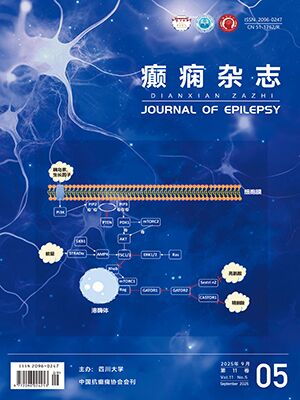| 1. |
Rosenow F, Luders H. Presurgical evaluation of epilepsy. Brain, 2001, 124(2):1683-1670.
|
| 2. |
Jorge Genzalez-Martinez, Juan Bulacio. Stereoelectroencephalo-graphy in the "difficult to localize" refractory focal epilepsy:early experience from a North American epilepsy center. Epilepsia, 2013, 54(2):323-330.
|
| 3. |
Cossu M, Cardinale F, Castana L, et al. Stereoelectroencephalo-graphy in the presurgical evaluation of focal epilepsy:a retrospective analysis of 215 procedures. Neurosurgery, 2005, 57(8):706-718.
|
| 4. |
Jorg Wellmer, Ferdinand von, der Groeben, et al. Risks and benefits of invasive epilepsy surgery workup with implanted subdural and depth electrodes. Epilepsia, 2012, 53(8):1322-1332.
|
| 5. |
Scott C, Fish D, Smith S, et al. Presurgical evaluation of patients with epilepsy and normal MRI:role of scalp video-EEG telemetry. J Neurol Neurosurg Psychiatry, 1999, 66(8):69-71.
|
| 6. |
Chapman K, Wyllie E, Najm I, et al.Seizure outcome after epilepsy surgery in patients with normal preoperative MRI. J Neurol Neurosurg Psychiatry, 2005, 76(4):710-713.
|
| 7. |
Talairach J, Tournoux P, Musolino A, et al. Stereotaxic exploration in frontal epilepsy. Adv Neurol, 1992, 57(8):651-688.
|
| 8. |
Rasmussen T. Tailoring of cortical excisions for frontal lobe epilepsy. Can J Neurol Sci, 1991, 18(Suppl 4):606-610.
|
| 9. |
Williamson P, Jobst B. Frontal lobe epilepsy. Adv Neurol, 2000, 84(11):215-242.
|
| 10. |
Aileen Mc Gonigal, Fabrice Bartolomei, Jean Regis, et al. Stereoelectroencephalography in presurgical assessment of MRI-negative epilepsy. Brain, 2007, 130(5):3169-3183.
|
| 11. |
Bancaud J, Angelergues R, Bernouilli C, et al. Functional stereotaxic exploration (SEEG) of epilepsy. Electroencephalogr Clin Neurophysiol, 1970, 28(6):85-86.
|
| 12. |
Guenot M, Isnard J, Ryvlin P, et al. Neurophysiological monitoring for epilepsy surgery:the talairach SEEG method-results, complications and therapeutic applications in a series of 100 consecutive cases. Stereotact Funct Neurosurg, 2001, 77(2):29-32.
|
| 13. |
Hamer H, Morris H, Mascha E, et al.Complications of invasive video-EEG monitoring with subdural grid electrodes. Neurology, 2002, 58(11):97-103.
|
| 14. |
Burneo J, Steven D, McLachlan R, et al. Morbidity associated with the use of intracranial electrodes for epilepsy surgery. Can J Neurol Sci, 2006, 33(10):223-227.
|
| 15. |
Wong C, Birkett J, Byth K, et al. Risk factors for complications during intracranial electrode recording in presurgical evaluation of drug resistant partial epilepsy. Acta Neurochir (Wien), 2009, 151(6):37-50.
|
| 16. |
Najm I, Bingaman W, L_ders H. The use of subdural grids in the management of focal malformations due to abnormal cortical development. Neurosurg Clin, 2002, 13(3):87-92.
|
| 17. |
杨岸超, 孟凡刚, 张建国, 等.颅内电极长程记录在癫痫外科中的应用价值.中华神经外科杂志, 2010, 26(11):1013-1016.
|
| 18. |
马元施, 石先俊, 李维, 等.立体脑电图与硬膜下皮层电极监测在癫痫评估中的比较——立体脑电图具有更少的出血和感染并发症.癫痫杂志, 2015, 1(3):203-208.
|
| 19. |
Van Gompel JJ, Worrell GA, Bell MI, et a1.Intracranial electroencephalography with subdural grid electrodes:techniques, complications, and outcomes.Neurosurgery, 2008, 63(2):498-506.
|
| 20. |
Fountas KN, Smith JR.Subdural electrode-associated complications:a 20-year experience. Stereotact Funct Neurosurg, 2007, 85(3):264-272.
|
| 21. |
Rydenhag B, Silander H. Complications of epilepsy surgery after 654 procedures in Sweden, September 1990-1995:a multicenter study based on the Swedish National Epilepsy Surgery Register. Neurosurgery, 2001, 49(4):51-56.
|
| 22. |
Jeffrey P Mullin, Daniel Sexton, Jorge Gonzalez-Martinez, et al. Outcomes of subdural gride electrode monitoring in the Stereoelectroencephalography. Era World Neurosurg, 2016, 89(7):255-258.
|




